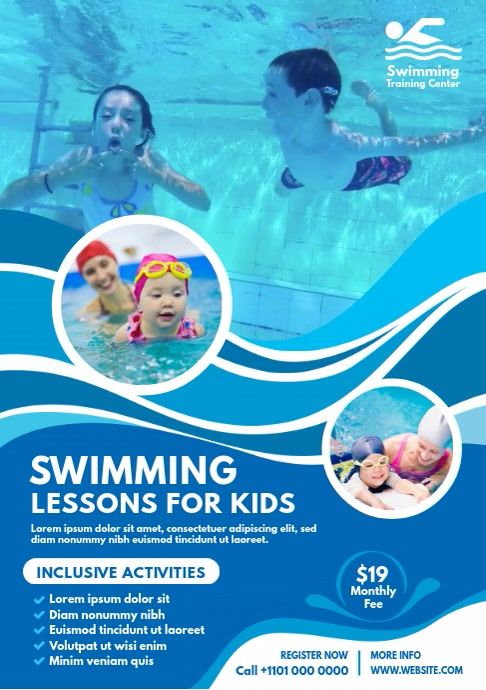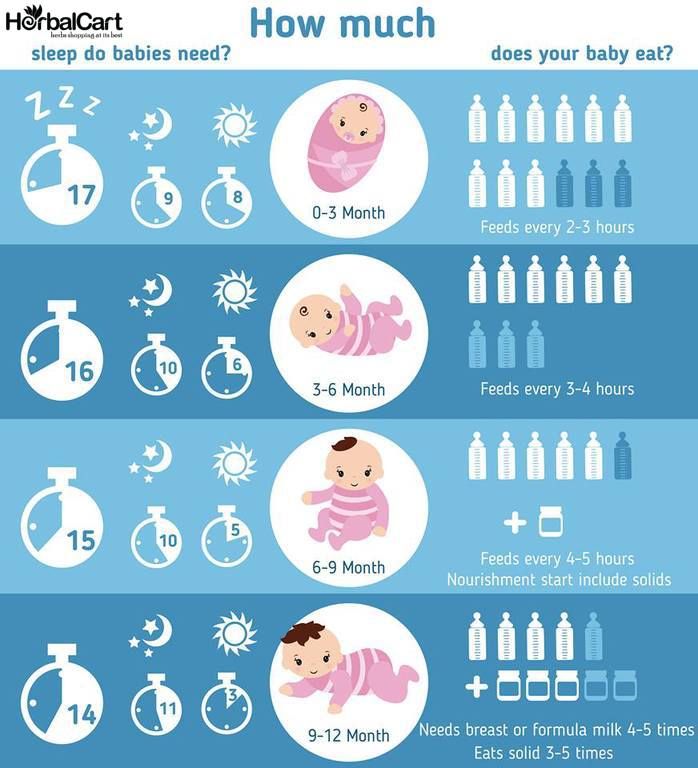When to start baby swimming lessons
When Is a Good Time to Start Swim Lessons?
In the United States, swimming is the most popular recreational activity for children and teenagers and the fourth most popular recreational activity overall. It's also a form of exercise, which is great for heart health and combating childhood obesity. Experts suggest that swimming is even excellent for your mental health.
Swimming is undoubtedly good for you — but at what age should you introduce it to your child? Read on to learn why teaching your child how to swim at an early age is essential, as well as tips for fostering a fun and safe learning experience.
The Best Age to Start Swim Lessons
Studies show that the best time for a child to start learning swim basics is between the ages of 1 and 4. However, infants aged 6 months to 3 years can participate in Parent and Child Lessons at the Y to start enjoying and getting acclimated to the water. These lessons also teach parents crucial water safety skills to better educate and protect your child. If your child is older than 4, don't worry. It's never too late to learn. Ages 4 and up are when kids begin to grasp the techniques of swimming, like floating and swimming to a specific destination.
Enrolling your child in swim lessons between the ages of 6 months and 4 years is the most effective way to help them acclimate to water. This early acclimation will encourage them not to fear swimming as their lessons get more challenging.
Benefits of Learning to Swim at a Young Age
Learning to swim at a young age can be very beneficial for your child's mental and physical development, help keep them safe and build lifelong skills.
These are just a few advantages of teaching your child how to swim early in life.
- It builds a robust foundation for a healthy lifestyle: Swimming keeps kids healthy and exercises key areas of their physical development, including lung and muscle health, flexibility and stamina.
- They'll know what to do if they fall in: Formal swim lessons will teach your child the necessary survival skills they need to stay safe around the water.

- It builds vital skills: In addition to your child's physical development, swim lessons allow your child to meet other kids their age and practice their social skills. Because they have a shared interest, they might even make some new friends!
- It's a break from screen time: Today, children are spending more time watching screens than ever before. Too much screen time often links to obesity, irregular sleep and behavioral problems. Experts recommend all children under 5 years old engage in less screen time to grow up healthier. Swimming is the ideal opportunity to introduce non-screen activities into your child's routine.
- It could encourage a new interest: When your child learns to swim at a young age, it will encourage them to pursue new things with confidence, and could even spark an interest in other water-related activities like professional swimming, kayaking, diving and more.
What If My Child Doesn't Like It?
If you have started to introduce your child to the pool or enrolled them in swim lessons, only to find they don't enjoy it, don't worry! You can take a few steps to make the experience more enjoyable for both of you, and encourage them to view swimming differently.
- Start at home: Before opting for a formal swim class or in between lessons, let your child get comfortable with water at home. Bathtime is the perfect opportunity to get them used to the idea of being submerged in the water. Show them how much fun they can have by blowing bubbles or making small splashes.
- Let them watch others swim: If your child is resisting swim lessons because they are afraid or unsure what to expect, let them watch you as you or other children around their same age enjoy the pool. You will help your child begin to see swimming as a fun activity rather than a lesson to learn or an obstacle to overcome.
- Make it fun: Don't let swimming lessons be a source of stress or worry for your child. Implement rewards, goals and activities to make it a fun and exciting time. Pool games are a great motivator and help your child learn how to float, kick and tread water without realizing it. You should also consider using a variety of toys and objects to make swim time more engaging, like pool noodles, goggles and snorkels.
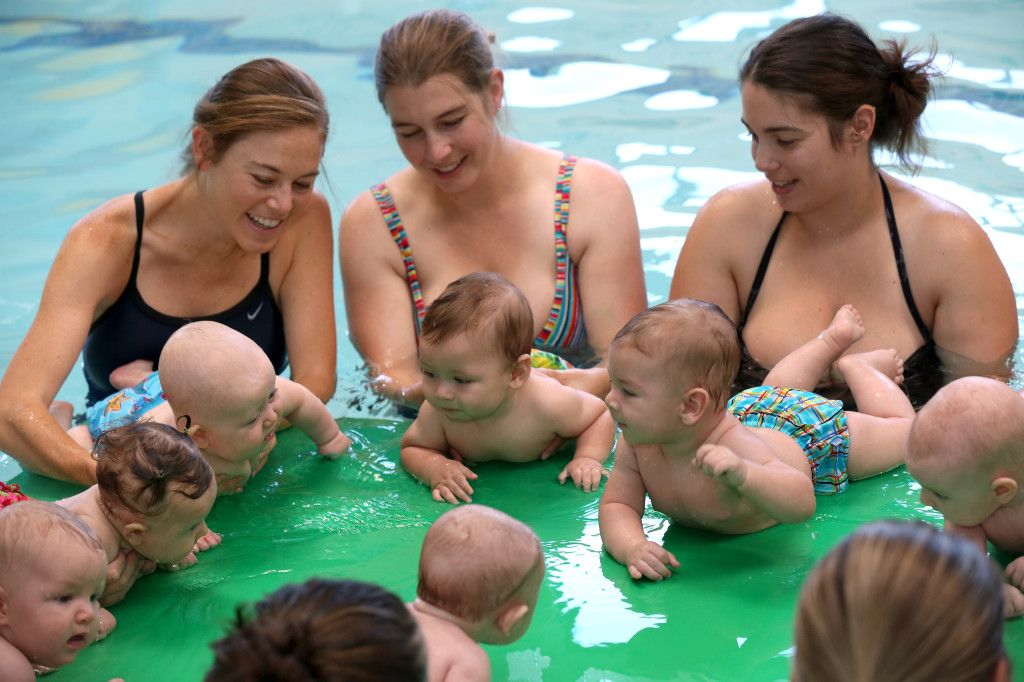
- Establish a routine: Repetition is an essential part of learning any new skill. Incorporate regular swimming lessons into your child's weekly routine. Doing so will give them something to look forward to and provide a chance to continue developing their ability over time.
- Don't force it: If you've tried everything to encourage your child to enjoy swimming and nothing seems to work, it's best to let it go for now. It's possible that, in the future, they will become more curious and want to try again. In the meantime, there are several other ways to help your child stay active and develop social skills.
Tips for Safe Swim Lessons
While enrolling your child in formal swim lessons at a young age can be very beneficial to their social and physical development, it's ultimately your decision. You know what's best for your child. If you've decided to pursue lessons, that's great!
For a safe and enjoyable experience, keep these swimming safety tips in mind:
- Check that the water is at a comfortable temperature — not too hot and not too cold.
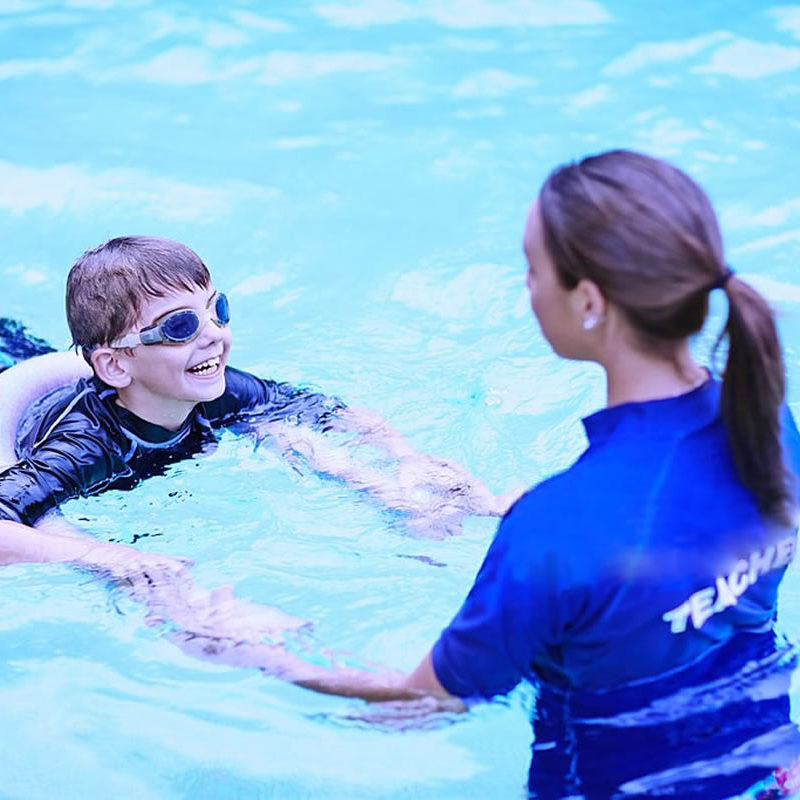
- Teach your child how to use flotation devices, including throw rings, so they know how to respond in an emergency.
- Enroll your child in formal swim lessons. Working one-on-one with your child is a good way to make them more comfortable with swimming, but lifeguards are trained professionals and equipped to handle lessons safely and effectively.
- Choose your child's swim lessons carefully. Classes should be small, focused and led by a certified instructor. Keep in mind that not every program is suitable for all children. If your child isn't enjoying or benefiting from swim lessons, search other local options.
- When your child is swimming outside their formal lessons, monitor them at all times. Know how to recognize signs of stress in the water and consider taking an emergency CPR class.
- If your child is just starting, practice in a supervised pool before moving on to more unpredictable bodies of water, like a lake or ocean.
Learn More About Swimming Lessons at the Y
A trained, caring instructor leads every swimming lesson at a Gateway Region YMCA.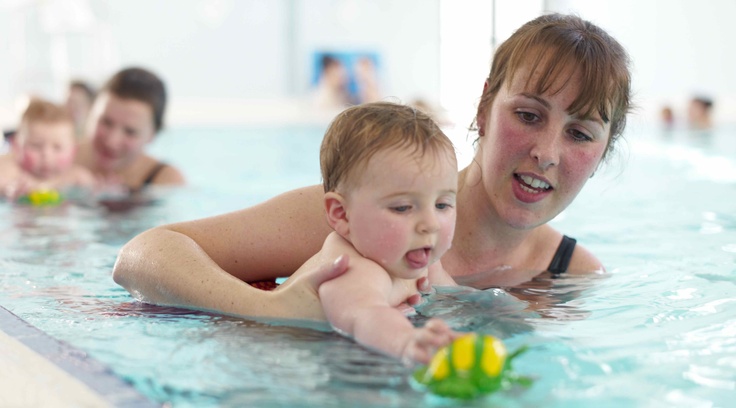 Our teachers emphasize water safety skills and focus on conquering milestones based on your child's experience and progress. Lifeguards conduct lessons in private, semi-private or small class environments, so each child receives the level of attention and guidance they need. With the Gateway Region YMCA SwimWins communication tool, you'll also enjoy staying informed about every part of your child's swim journey. If you prefer a more hands-on approach, you could also consider a parent-and-child swim lesson to create lasting memories together.
Our teachers emphasize water safety skills and focus on conquering milestones based on your child's experience and progress. Lifeguards conduct lessons in private, semi-private or small class environments, so each child receives the level of attention and guidance they need. With the Gateway Region YMCA SwimWins communication tool, you'll also enjoy staying informed about every part of your child's swim journey. If you prefer a more hands-on approach, you could also consider a parent-and-child swim lesson to create lasting memories together.
To learn more, visit us online or find a Y near you!
Infant Swimming: When Can a Baby Start Swimming?
Playing in the water, whether it's learning to swim or just splashing and paddling, is lots of fun for babies and young children. And knowing how to swim is an important skill that can help keep your child safe all through life. That's why getting started with swimming lessons once your child is old enough is a smart strategy. Even if your baby isn’t ready just yet, you might consider doing water play to get her primed for swimming lessons in the future.
Even if your baby isn’t ready just yet, you might consider doing water play to get her primed for swimming lessons in the future.
Find out when you might start your little one on swimming lessons, and the signs of readiness to look for.
Water safety is a top priority at every age and stage. Read on for some essential water safety advice that you should follow whenever your baby, toddler, or preschooler is in or near water.
When Can You Take Your Baby Swimming?
Experts recommend that you can start taking your little one to parent-child swimming classes as early as age 1. Because every child is different, though, you may find your little one isn’t ready to start swimming lessons until a little later.
It’s important to know that newborns and infants younger than 12 months old aren’t yet able to raise their heads above the water to breathe, so swimming lessons aren’t yet appropriate for them.
In your baby’s first year, you might like to do parent-child water play classes with your baby to help him get used to being in water.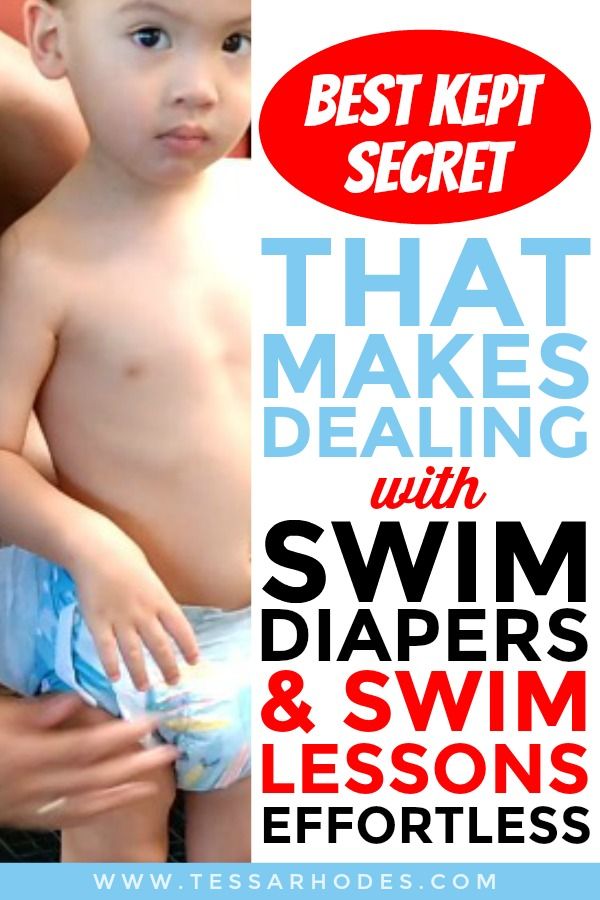 This can
This can
get him accustomed to being in a pool
be an opportunity for bonding as you play together in the water
help him get over any fears he may have of being in the water.
When deciding when to start your child on swimming lessons, take into account his
emotional maturity
physical and developmental abilities or limitations
interest in learning to swim
comfort level in water.
Most children are ready for regular swimming lessons by the age of 4 when they can grasp basic skills such as
floating
treading water
finding a way out of the water.
If you’re ever unsure when to start your child on swimming lessons, ask your child’s healthcare provider for personalized advice.
Benefits of Swimming Lessons
Knowing how to swim is very important, as it can help prevent drowning. Studies have shown that swimming lessons can help reduce the drowning risk for toddlers and young children between the ages of 1 and 4, so you may like to take this into account when deciding when to start your little one on lessons.
Studies have shown that swimming lessons can help reduce the drowning risk for toddlers and young children between the ages of 1 and 4, so you may like to take this into account when deciding when to start your little one on lessons.
Still, know that swimming lessons don’t make your child “drown proof.” You will need to carefully supervise your child whenever she is in or near water. And, if you have a pool at home, it's crucial to block access when you’re not there to supervise. You can learn more about this in our section on water safety.
On the bright side, swimming and water play can be fun activities for your child. Like many sports, swimming can help build confidence and it can be a steppingstone for developing other life skills.
What Kind of Swimming Lessons Should You Enroll Your Child In?
Toddlers and young children may benefit from classes that focus on swim readiness skills. Parents are often included in these classes, and can pick up pointers on how to safely supervise their child.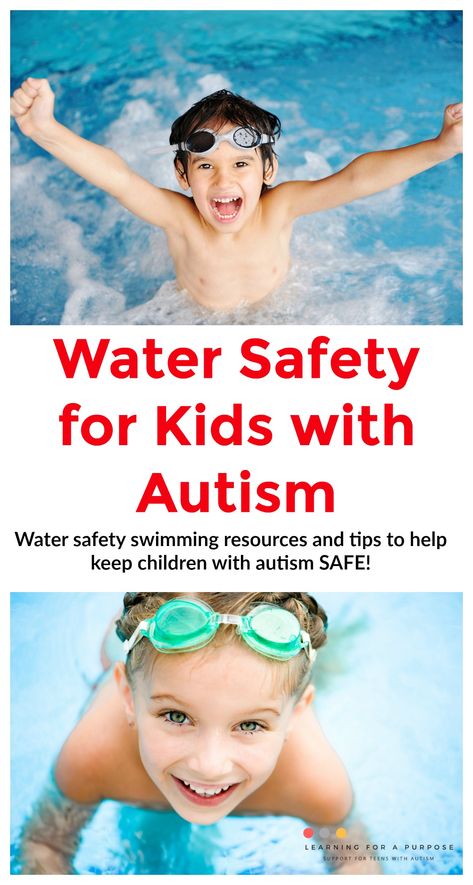
By the time children turn 4 years old, they are usually ready for standard swimming lessons. These would include learning stroke techniques as well as water survival skills such as
getting back to the water’s surface from under water
propelling a minimum of 25 yards
getting out of the water.
When choosing a swimming instructor for your child, check that the instructor
is qualified and certified to teach swimming
will give you the chance to observe a lesson in action before you make a decision
offers an atmosphere that is appropriate to your child’s age and development
encourages safe habits such as never swimming alone or without permission from an adult
can teach your child what to do if he falls into water by accident
allows you to be near or alongside your child in the water
requires your child to take multiple lessons so that there is noticeable progress
evaluates how your child is progressing and gives you feedback after lessons.
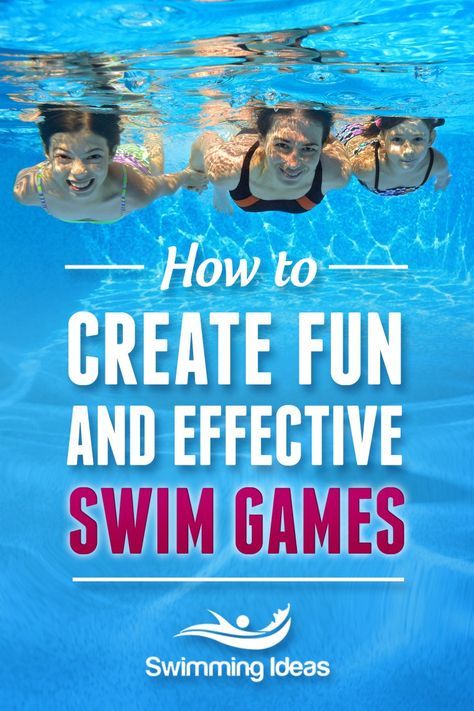
Besides all of this, you should check out the swimming facility firsthand. Ensure that the water is clean, disinfected, and chlorinated. Ideally, the water would be heated to between 87 and 94 degrees Fahrenheit. Water temperature is especially important for children under the age of 3, who are at a higher risk of hypothermia.
To locate good quality swimming instruction near you, check with the American Red Cross or your local YMCA.
How Do You Ensure Water Safety for Your Child?
Providing constant, focused supervision is the most important thing you can do for baby or young child who is learning to swim or is in or near water.
Childhood drowning is more common than you might think, and young children can drown in just an inch or two of water. It pays to be extra vigilant when your child is around water.
Here are some important steps to take to help keep your child safe when she is swimming or is anywhere near water:
Always give your child your undivided attention.
 Don’t think that because there’s an on-duty lifeguard by the pool or at the beach that you can read a book or use your smartphone.
Don’t think that because there’s an on-duty lifeguard by the pool or at the beach that you can read a book or use your smartphone.Don’t drink alcohol or use drugs when supervising your child
If your child is learning swimming at a younger age, it will be important for you to do “touch supervision,” which entails you being close by or joining her in the pool
Don’t leave your child in the water under the supervision of another child
If you’re hosting or attending a pool party, assign the job of a “water watcher” to someone who can keep a constant eye on the children in the pool. Rotate the job in shifts so someone else can take over the responsibility after a short time. Make sure that the water watcher knows CPR and knows how to swim.
Keep an extra close watch on toddlers and young children between the ages of 1 and 4 as they are at the highest risk of drowning. If your child is in this age range, she’s naturally very curious and can easily sneak away from you even when it’s not swimming time.
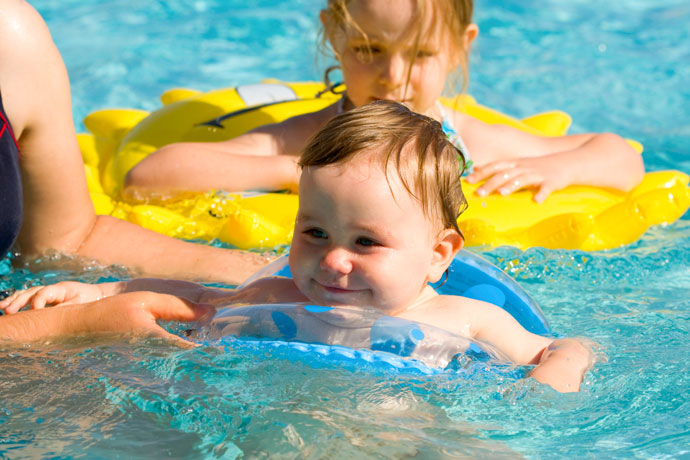 This is why it’s important to secure your home swimming pool if you have one.
This is why it’s important to secure your home swimming pool if you have one.If you’re at the beach, a lake, or a river, make sure your child wears a life jacket that fits properly and has been approved by the U.S. Coast Guard. If your child isn’t a strong swimmer, she may also need to wear a life jacket at the pool or water park.
Be prepared to respond if your little one’s in trouble in the water. It’s a good idea for you to learn CPR and rescue techniques. Classes are available through the American Red Cross and the American Heart Association. Your local fire department and other community organizations may also offer first-aid classes.
Keep in mind that whenever your child is swimming outdoors you should also make sure that her skin is protected from the harmful effects of the sun with sunscreen.
Home Swimming Pool Safety
If you have a swimming pool at home, you'll need to follow certain rules while it’s in use and keep it secured when it’s not being used.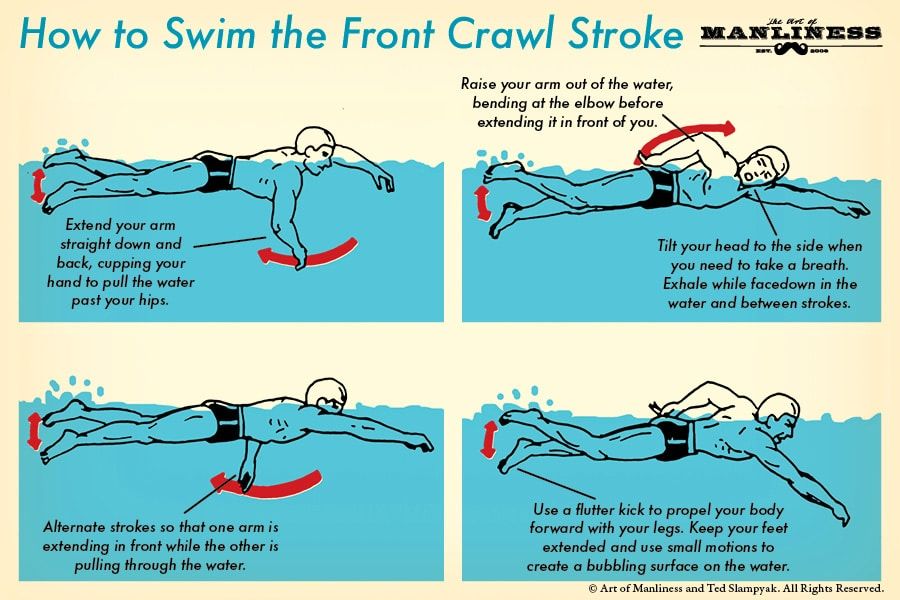
When your swimming pool is in use, follow these guidelines:
Don’t let children run around the pool or push one another into the pool
Don’t let your child use an inflatable mattress or floating toy, as he may slip off it into deep water or it may deflate unexpectedly, endangering your child’s safety
Make sure that the deep and shallow ends of your pool are marked, and never let your child dive into the shallow end
Remove the pool cover completely before letting anyone swim
Don’t let your child walk on the pool cover while it’s covering the pool, as he could accidentally fall in the pool and get trapped underneath
Make sure your pool’s drain covers are properly maintained, as suction from drains can trap swimmers. You may even consider installing anti-entrapment drain covers
It’s a good idea to have a safety ring connected to a rope or a shepherd’s hook near your swimming pool.
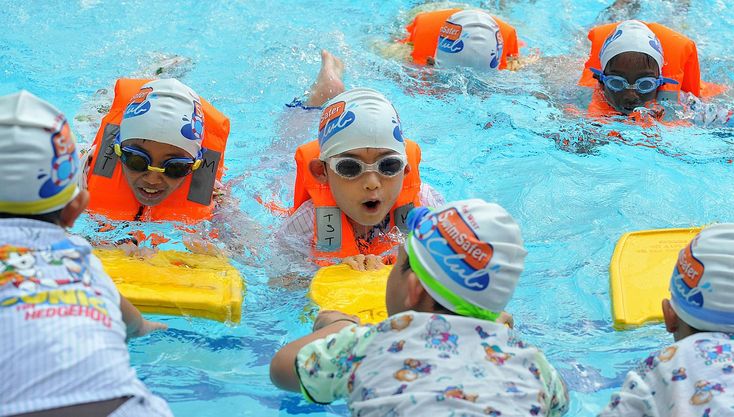
Here’s how to keep your swimming pool secured when not in use:
Surround your pool (including above-ground and inflatable pools) with a fence on all sides
The fence should be a minimum of four feet high and have no opening in the slats wider than four inches
The gate of the fence should be self-closing and self-latching. The latch should be at least 54 inches above the ground, and the gate should open away from the pool.
Make sure that the gate is always securely locked
It’s a good idea to keep your pool covered, but a pool cover should never replace the use of a fence
Check your local laws to find out whether there are any additional safety requirements for your home swimming pool
Don’t leave toys in or around the pool, as these are enticing to children even when it’s not swimming time
If you have a spa, hot tub, or whirlpool, keep it covered and locked when not in use.
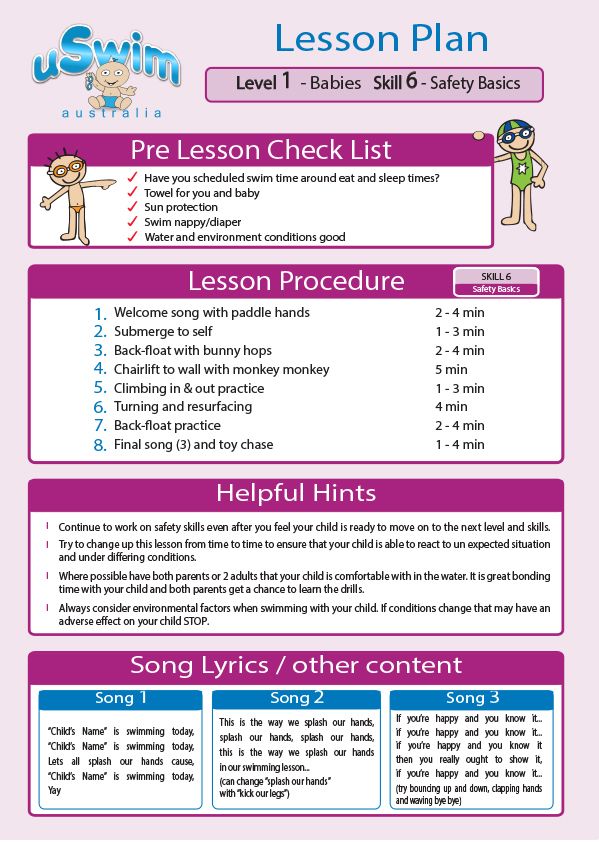 Keep in mind that children under the age of 5 should not be allowed to use these to help reduce the risk of drowning or overheating. Also, remember: Never leave your baby or child unattended in the bathtub not even for a moment.
Keep in mind that children under the age of 5 should not be allowed to use these to help reduce the risk of drowning or overheating. Also, remember: Never leave your baby or child unattended in the bathtub not even for a moment.
Enrolling your little one in swimming lessons once he’s old enough can give your child lifelong skills and confidence in the water. Even in your baby’s first year, you can consider water play classes to familiarize your baby with water and to set the stage for learning to swim.
Whether your little one is playing on a beach, splashing in a tub, or paddling in a pool, remember to always practice good water safety habits. Enjoy this time together!
How we wrote this article The information in this article is based on the expert advice found in trusted medical and government sources, such as the American Academy of Pediatrics and the American College of Obstetricians and Gynecologists. You can find a full list of sources used for this article below.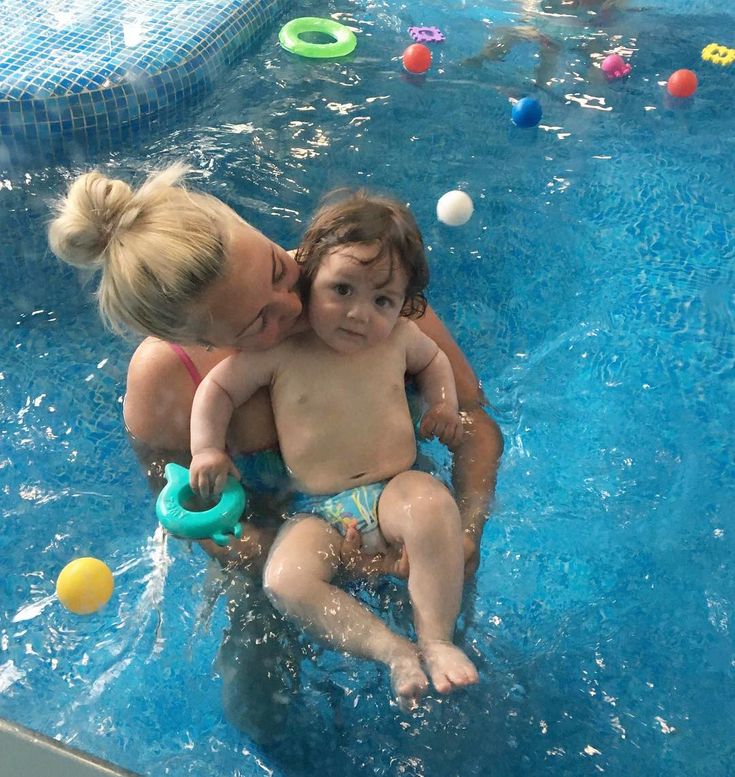 The content on this page should not replace professional medical advice. Always consult medical professionals for full diagnosis and treatment.
The content on this page should not replace professional medical advice. Always consult medical professionals for full diagnosis and treatment.
How to teach a child to swim, tips on how to quickly and correctly teach a child to swim
08/01/2019
Regular swimming lessons contribute to harmonious physical development. You should start from a very early age, gradually accustoming the child to the culture of being in the water. The fitness club "Premier Sport" in Moscow has created optimal conditions for learning to swim, experienced professional instructors work. An important point in this case is the correct training in technique, as well as safety during the child's stay in the water.
How to start learning to swim
Being in and under water are the natural physiological skills of a person, which he possesses from the moment of birth. Therefore, the sooner you start teaching your child to swim, the easier and more successful the process will be.
Physiologists recommend accustoming the baby to being in the aquatic environment as early as 3-4 weeks after birth. In this way, you can preserve and increase the natural ability of the newborn to stay on the water, as well as instinctively hold your breath for a short time.
- It is necessary to start training under the guidance of an experienced trainer who will be able to prepare the baby and parents for the learning process. The instructors of our club will introduce you to the technique of learning to swim, after which you will be able to continue your lessons on your own even at home. When your baby gets used to regular water procedures, you can develop the skills of staying in the water in individual lessons in infant swimming, where children from 3 months are invited.
- From the age of three, you can move on to more conscious training in this sport. In preparatory groups, under the guidance of an experienced methodologist, children master the correct swimming technique, learn how to competently hold their breath.
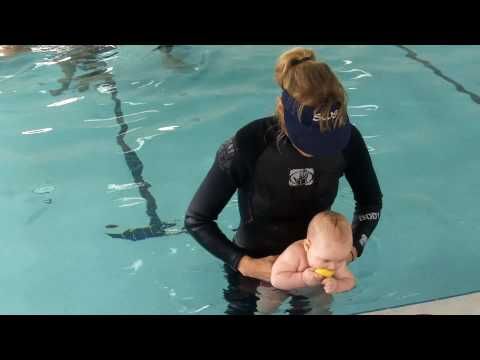 The main thing at this age is to conduct classes in a playful way, so that preschoolers are interested in the learning process, and there is an interest in the result.
The main thing at this age is to conduct classes in a playful way, so that preschoolers are interested in the learning process, and there is an interest in the result. - The age category from 5 to 13 years suggests more conscious practice of this sport. In the children's swimming school, the child will master the basic styles of swimming, get stronger physically, develop the skills and ability to stay on the water, dive, hold his breath.
Which types of swimming are faster and easier to teach a child
If your child does not have hydrophobia, the immune and cardiovascular systems are in order, you can begin to teach him to move in the aquatic environment. To do this, there are a variety of techniques and techniques, beginners should choose the simplest one.
- Like a dog - so your child will feel independent in the water, learn to control his movements and better feel his own body. When making strokes with your hands, with slightly bent legs, you should work up and down, while not forgetting to breathe rhythmically.

- After the "dog" style is mastered, you can proceed to the study of breaststroke. This is the most popular style among beginners, which is based on the synchronous movement of the limbs. At the same time, the arms “cut through” the water, straightening up and moving from front to back, and the legs make a horizontal push.
- Crawl on the chest (or freestyle) is accessible and understandable. For beginners, it will be easy to stay on the surface of the water on your chest, making alternating swings with your arms, and with your legs whipping the water like "scissors". This technique is easily absorbed by a child, allowing you to swim tens of meters without feeling very tired.
An important point in learning to swim is mastering the technique of proper breathing. If the child is physically developed and enjoys swimming, regularly practicing from scratch, you can achieve positive results in a few weeks.
#cardio #children #dancing #martial arts #fitness guide #health #intelligent body #motivation #Pilates #pregnancy #rehab #power training #swimming #tennis and squash #weight loss #yoga
when to start and what parents should know
back
Learning to swim should be a priority for every family.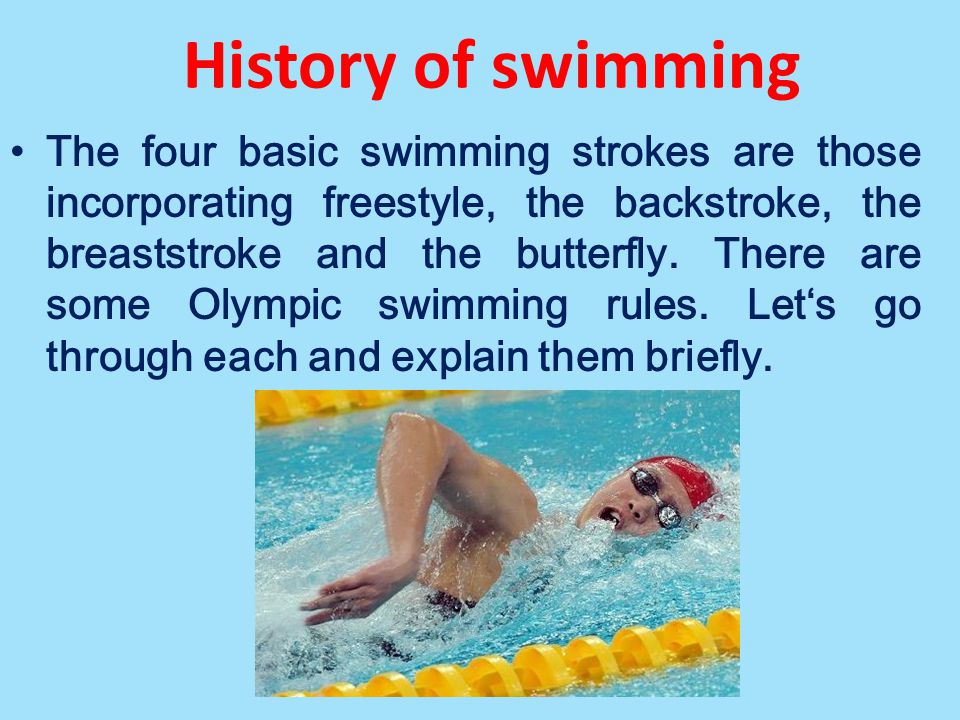 This is an important life skill that can play a key role in preventing drowning, the leading cause of death among children. Children and their parents should learn how to swim so that their time in the water is safe and fun!
This is an important life skill that can play a key role in preventing drowning, the leading cause of death among children. Children and their parents should learn how to swim so that their time in the water is safe and fun!
When should my child start learning to swim?
Children develop at different rates and not everyone is ready to start swimming lessons at the same age. When deciding when to enroll in swimming school, consider your child's emotional maturity, physical development and abilities, limitations, if any, and their level of comfort in the water.
Swimming pool activities for preschool children with their parents: useful for many families.
Recent studies show that water survival training and swimming lessons can help reduce the risk of drowning in children aged 1-4 years. Activities that involve both parents and their children are also a good way to introduce water safety skills and develop swimming skills. If your child seems ready, it's best to start lessons right away.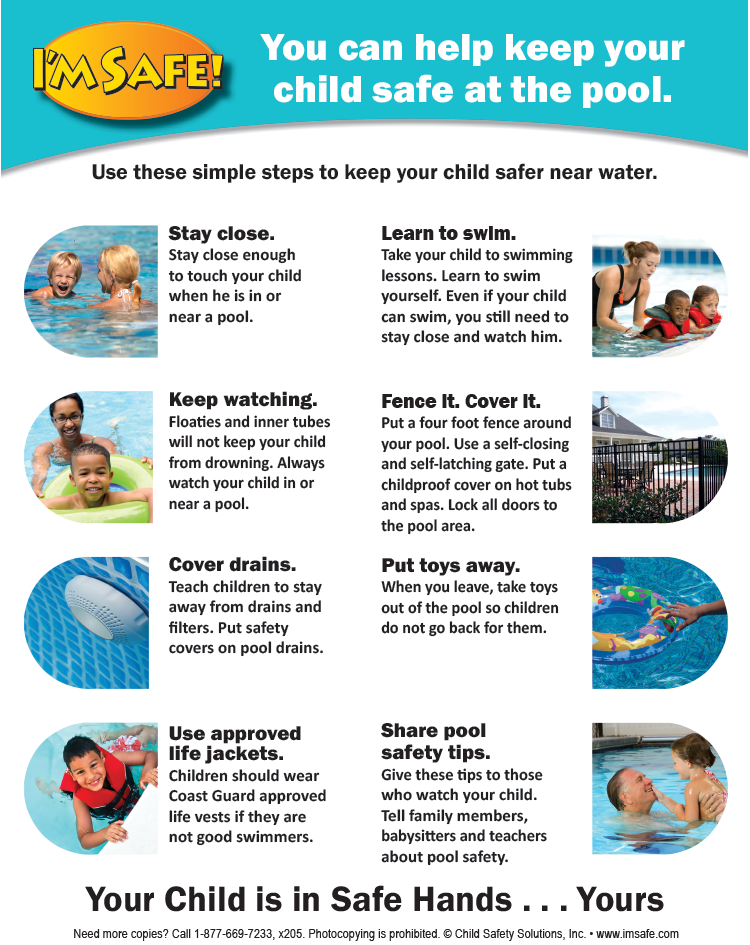
Swimming lessons for children aged 4 and over: a must for most families.
By the 4th birthday, most children are ready for swimming lessons in specialized sections. At this age, they can usually master basic water survival skills such as swimming, walking on water, and getting to an exit point. By the age of 5 or 6, most children in swimming lessons can already master the front crawl. If your child hasn't started learning to swim yet, now is the time!
Are swimming lessons recommended for newborns?
No, because there is currently no evidence that swimming programs for infants under 1 year of age reduce the risk of drowning. Babies this age may show reflex "swimming" movements, but are not yet able to lift their head out of the water well enough to breathe. However, you can sign up for parent-child water play classes to help your child get used to swimming in the pool; it can be a fun activity to enjoy together.
Remember that swimming does not protect children 100% from the risk of drowning.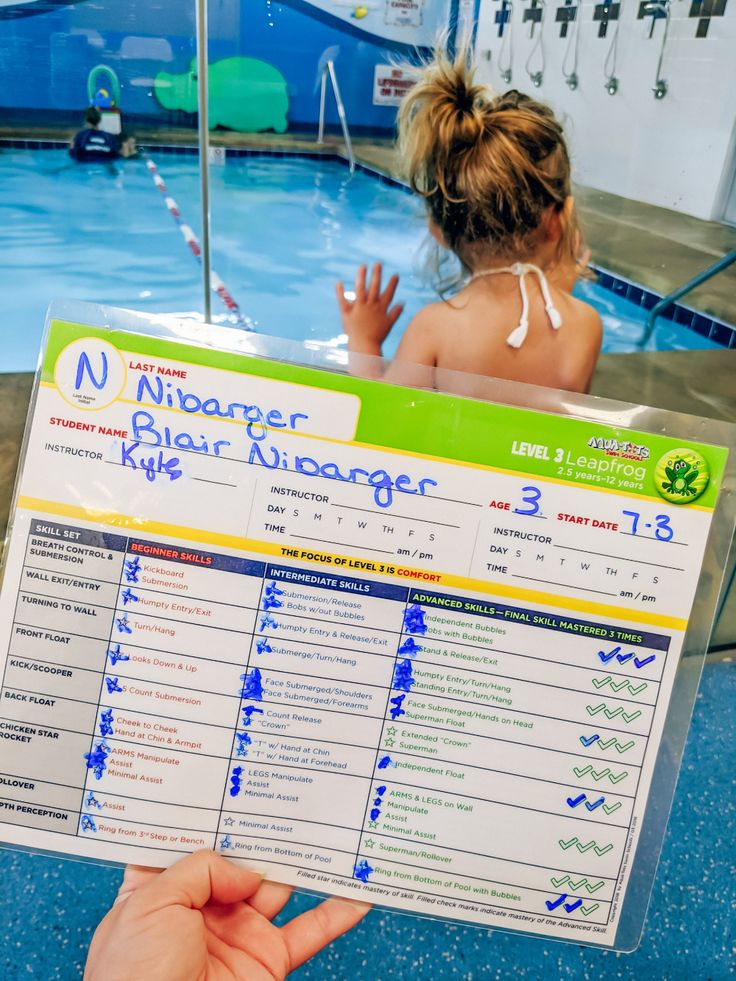
Always keep in mind that swimming lessons are just one of several important levels of protection needed to prevent drowning. Constant, focused supervision is essential when your child is in or near the pool or any other body of water. It is also important to block access to pools when there are no adults nearby who can supervise it.
What to look for when choosing a school or swimming class for children?
Look for schools and coaches that follow a program that focuses not only on swimming technique but also broader water survival skills. All children should learn how to return to the surface from underwater, move at least 25 meters and get out of the water on their own. Coaches and swimming instructors should evaluate children's progress and provide ongoing feedback on their skill level.
For children of all ages, look for swimming schools:
With qualified instructors and coaches. Swimming instructors must be proficient in teaching swimming techniques. Teach safety rules in, on and around the water. Children should learn to never swim alone or without adult supervision. Instructors should teach children to always ask permission from parents, lifeguards or swim instructors before they enter a pool or natural waters such as a lake. Teach them what to do if they suddenly find themselves in the water. Not all swimming teaching methods are the same and parents should explore the options to choose the one that is best for their child. Do children swim most of the time, or do they wait their turn during long periods of inactivity? Do children receive individual attention? Are the instructors friendly and knowledgeable? The Aqualeo Water Sports School invites children of all ages and skill levels to swim. Classes in the pool for children are conducted by professional trainers and instructors. The guys train according to a complex methodology: physical training, training in the gym + swimming pool, working out swimming techniques. For children with an advanced level of training, a water polo section is being recruited.
Children should learn to never swim alone or without adult supervision. Instructors should teach children to always ask permission from parents, lifeguards or swim instructors before they enter a pool or natural waters such as a lake. Teach them what to do if they suddenly find themselves in the water. Not all swimming teaching methods are the same and parents should explore the options to choose the one that is best for their child. Do children swim most of the time, or do they wait their turn during long periods of inactivity? Do children receive individual attention? Are the instructors friendly and knowledgeable? The Aqualeo Water Sports School invites children of all ages and skill levels to swim. Classes in the pool for children are conducted by professional trainers and instructors. The guys train according to a complex methodology: physical training, training in the gym + swimming pool, working out swimming techniques. For children with an advanced level of training, a water polo section is being recruited.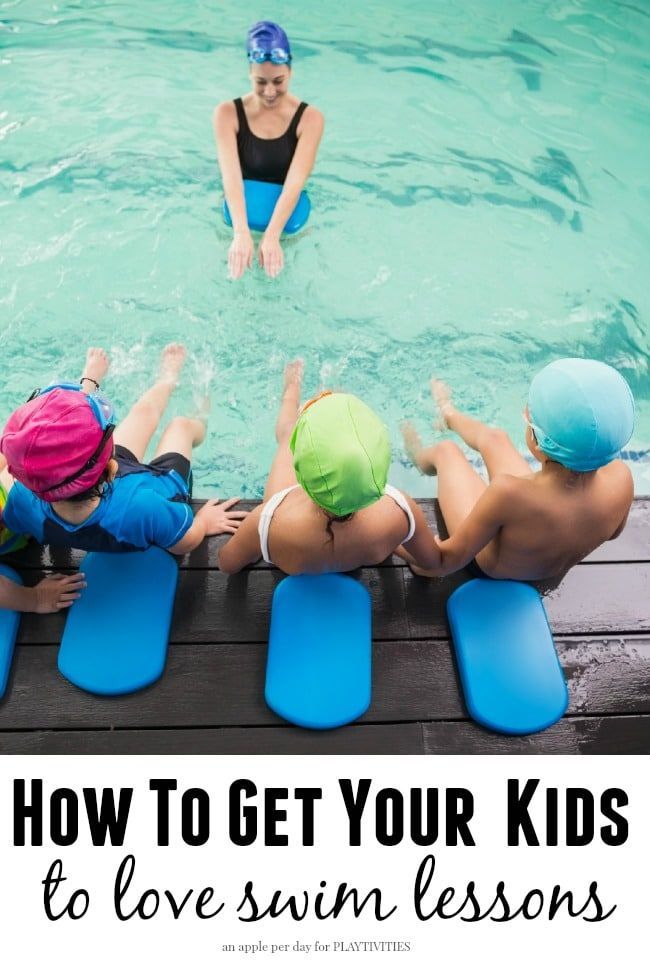 Several lessons are required. Once the children start the lessons, you will be able to see gradual but consistent progress in their abilities over time. Continue with lessons at least until they have mastered basic swimming skills.
Several lessons are required. Once the children start the lessons, you will be able to see gradual but consistent progress in their abilities over time. Continue with lessons at least until they have mastered basic swimming skills.
In addition, for children under 4, look for swimming schools that: Can provide an age-appropriate environment. Your child should feel safe during lessons and engage in activities that support their social, intellectual, physical and emotional development. However, children should develop a healthy relationship with water. Turn on "touch control". Whenever infants and young children are in or near water—even during swimming lessons—an adult must be within reach to provide "sensory control". Parent involvement should be encouraged, especially as it also helps families know what to do between classes. If you can't be in the water with your child, look for private lessons that offer personalized instruction. Maintain water purity. Young children are more likely to swallow or inhale water, so disinfecting the water and maintaining proper levels of chlorine is really important.